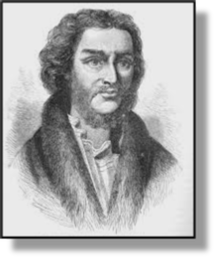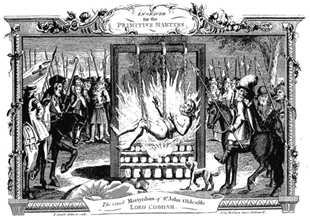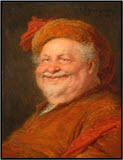


THE LOLLARDS 1414 -
Including:
Sir John
Oldcastle

xxxxxAs we have seen, in 1401 (H4) many anti-
xxxxxWe have seen how the anti-
 xxxxxEarly in this reign, however, in 1414, the Lollards staged a comeback, led by Sir John Oldcastle. It did not last long, but Oldcastle’s Rebellion, as it came to be called, proved an acute embarrassment for the king. Sir John had been a distinguished soldier. He had fought for Henry IV in the Scottish and Welsh campaigns and, during the fighting in Wales, he had become a friend and confident of the Prince of Wales, the present king.
xxxxxEarly in this reign, however, in 1414, the Lollards staged a comeback, led by Sir John Oldcastle. It did not last long, but Oldcastle’s Rebellion, as it came to be called, proved an acute embarrassment for the king. Sir John had been a distinguished soldier. He had fought for Henry IV in the Scottish and Welsh campaigns and, during the fighting in Wales, he had become a friend and confident of the Prince of Wales, the present king.
xxxxxBecause of his open support for the Lollards, Oldcastle was condemned by Archbishop Arundel, still as anxious as ever to stifle if not destroy this bunch of dangerous church reformers. The king tried to persuade Sir John to renounce his views, but when this failed he was brought to trial and condemned as a heretic. Again the king intervened. He had him imprisoned in the Tower of London, where he was given a stay of execution for forty days. But Oldcastle’s fate was sealed a few weeks later when he escaped from the Tower, called for a rally of Lollards just outside London, and conspired to kidnap the king. Those who turned up for the meeting were captured or dispersed. Reprisals were severe. Oldcastle himself managed to escape, but was eventually caught in November 1417, and the following month was hanged over a fire that consumed the gallows.
imprisoned in the Tower of London, where he was given a stay of execution for forty days. But Oldcastle’s fate was sealed a few weeks later when he escaped from the Tower, called for a rally of Lollards just outside London, and conspired to kidnap the king. Those who turned up for the meeting were captured or dispersed. Reprisals were severe. Oldcastle himself managed to escape, but was eventually caught in November 1417, and the following month was hanged over a fire that consumed the gallows.
xxxxxFollowing the failure of Oldcastle’s Rebellion, the Lollard movement went underground for a second time, and this time it stayed there. However, it still remained a force for change, especially in London and East Anglia, and in about 1500 a marked revival began despite continued persecution. The movement eventually merged with the new Protestant forces and, as it was already in being, it played an important part in conditioning public opinion to accept church reforms put forward by Henry VIII.
Henry VIII.
xxxxxIncidentally, Shakespeare had a character named Sir John Oldcastle in the first version of his play Henry IV, but, as a fat, dishonest and cowardly knight, he bore no resemblance to the real Sir John. He later changed the name to Falstaff, probably because of protests from aggrieved descendants.



Acknowledgements
Oldcastle: engraving, artist unknown, from The History of Protestantism by the Scottish historian James Aitken Wylie (1808-
H5-